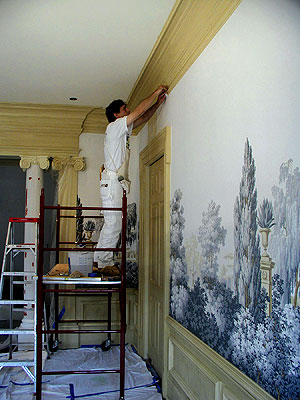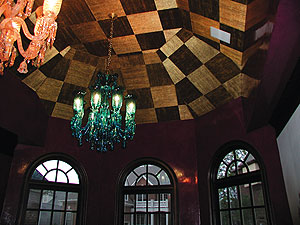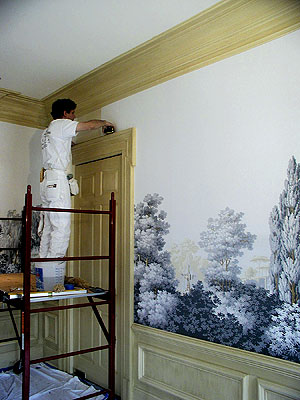|

Chris Murphy, Paperhanger Ltd., Atlanta, Ga.
by Christina Camara
Combine those traits with professional training and a belief that his reputation is at stake on every job, and you've created the equation for a successful paperhanging business.
Not that it started out that way. Murphy, now 51, started painting houses in college, reading paint cans and bothering the paint store employees with his inquiries. After graduating from the State University of New York at Binghamton, he kept another college job, working as railroad trackman, but it was seasonal work, so during the winters he helped out two neighbors who owned a wallpaper store.
 While there, he read an article in the New York Times about a paperhanger who had installed a "circus ceiling." The stripes on the wallpaper converged at the center of the ceiling, making it look like a circus tent. This wasn't ordinary paperhanging. It captured Murphy's imagination, sparked his natural curiosity and landed him at the U.S. School of Professional Paperhanging in Rutland, Vt., where he graduated in 1979. (The school's owner, Stan Warshaw, has since retired.) While there, he read an article in the New York Times about a paperhanger who had installed a "circus ceiling." The stripes on the wallpaper converged at the center of the ceiling, making it look like a circus tent. This wasn't ordinary paperhanging. It captured Murphy's imagination, sparked his natural curiosity and landed him at the U.S. School of Professional Paperhanging in Rutland, Vt., where he graduated in 1979. (The school's owner, Stan Warshaw, has since retired.)
"I had a college degree and I expected more out of myself," he says. "I thought, 'If I'm going to hang paper, I'm going to be a darn good paperhanger.'"
Now Murphy operates his one-man business in the Atlanta area, specializing in high-end papers for private homes. Like most successful business owners, getting to this point involved some luck. You could say he created his own luck.
Through a business partner in the early 1980s, Murphy took over work hanging paper at a "to-the-trade" showroom in the Atlanta area, experimenting with new products and techniques, putting extra care into the smallest of displays, and meeting interior designers. Soon the designers noticed his attention to detail and started referring him for high-end residential jobs — exactly the market he wanted to break into.
He gets almost all his business from showroom referrals now, but that wasn't his motivation at first. He just wanted to do a good job. Working with expensive, top-quality English papers, hand-screen prints and other specialty products intrigued Murphy then and now.
 Another bit of luck for Murphy was the evolution of the wallpaper market. While the popularity of mass-market, prepasted, pretrimmed papers has plummeted, the high-end products that Murphy prefers are holding their own. Another bit of luck for Murphy was the evolution of the wallpaper market. While the popularity of mass-market, prepasted, pretrimmed papers has plummeted, the high-end products that Murphy prefers are holding their own.
Murphy estimated the industry has lost 85 percent of its business since 1980, "but there will always be a demand for wall treatments other than paint or faux finishes, and that's where wallcovering comes in."
Homeowners with good taste and big budgets turn to wallcoverings for tiny powder rooms, sweeping front entrances or elegant dining rooms, and they're not buying vinyl. They are captivated by tasteful English pulp papers or French or Chinese handmade murals, which can cost $15,000 to $50,000. That's just for the paper, and it doesn't even go to the floor; it stops at the chair rail.
Murphy is especially proud of one job in which he hung a French mural, which was woodblock printed with watercolors on pulp paper, on a 12-foot-high curved dining room wall. It's nearly impossible to line up the seams precisely under those conditions. But Murphy asked for help, and figured out how to butt one seam and trim the other on the wall in a way that worked well, and worked quickly.
"It's like walking a tightrope. One little twitch and it's all over for you," he says. "The focus is intense. I can't blame folks who don't want to do it."
 Textured wallcoverings have been particularly popular over the last couple of years — grasscloth, weaves, laminated textiles and "the dreaded" bamboos. ("It's like grasscloth on steroids with a genetic change. It's a real pain.") Textured wallcoverings have been particularly popular over the last couple of years — grasscloth, weaves, laminated textiles and "the dreaded" bamboos. ("It's like grasscloth on steroids with a genetic change. It's a real pain.")
"Those high-end papers require old-time skills that are not being taught anymore," Murphy says. "Most paperhangers now only know clear pre-mixed pastes, how to use a pasting machine, and double-cutting. The finer wallcoverings need much more knowledge and skill." That's why Murphy gets jobs that other hangers don't want or that are so costly that the homeowners demand a specialist.
Murphy says that there's really only one way to make it in the paperhanging business these days, and that is by constantly learning new skills to hang every type of wallcovering. That's why his membership in the National Guild of Paperhanging Professionals Inc. (NGPP) is invaluable.
No one knows it all, Murphy says. "The NGPP gives me access to hardworking, intelligent craftsmen who are not afraid to tell me just how they got through a day with a particular wallcovering, or even to come on my jobs and give me their best work," he says. "I've gotten thousands of dollars of work through members, too."
 Guild members have successfully experimented with hanging papers embedded with tiny glass beads, hanging copper sheets, wooden wall coverings and more. Guild members have successfully experimented with hanging papers embedded with tiny glass beads, hanging copper sheets, wooden wall coverings and more.
Murphy hasn't stopped asking questions either, and NGPP gives him access to the industry. Gone are the days of running down to the local paint store to find the right tools, pastes, primers or liners. The successful hangers go to conventions and workshops to pick the brains of the suppliers, and of course Murphy talks to everyone from the CEO to the chemist to the sales rep.
Working with delicate, expensive papers in million-dollar homes is challenging, but Murphy isn't afraid of anything new. "I've made my mistakes and paid good money to fix them, but you learn more from your mistakes than you do from your successes."

|

